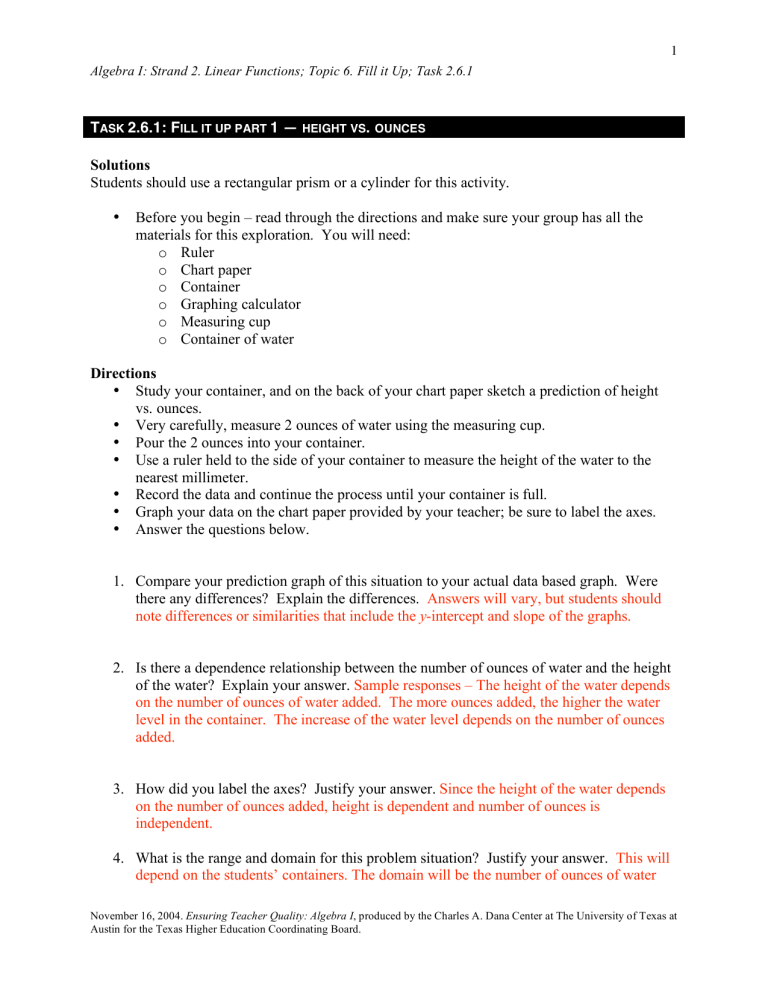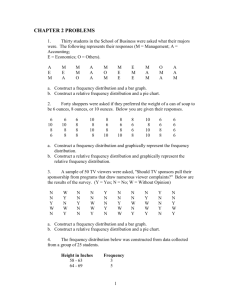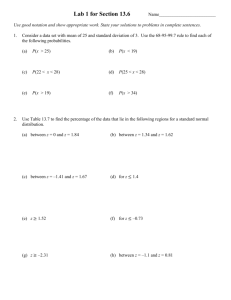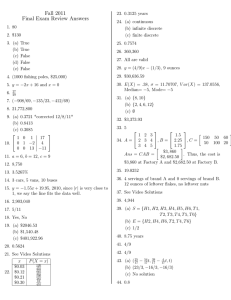Document 11665283

Algebra I: Strand 2. Linear Functions; Topic 6. Fill it Up; Task 2.6.1
T ASK 2.6.1: F ILL IT UP PART 1 — HEIGHT VS . OUNCES
Solutions
Students should use a rectangular prism or a cylinder for this activity.
• Before you begin – read through the directions and make sure your group has all the materials for this exploration. You will need: o Ruler o Chart paper
Directions o Container o Graphing calculator o Measuring cup o Container of water
• Study your container, and on the back of your chart paper sketch a prediction of height vs. ounces.
•
Very carefully, measure 2 ounces of water using the measuring cup.
•
Pour the 2 ounces into your container.
• Use a ruler held to the side of your container to measure the height of the water to the nearest millimeter.
•
Record the data and continue the process until your container is full.
•
Graph your data on the chart paper provided by your teacher; be sure to label the axes.
• Answer the questions below.
1.
Compare your prediction graph of this situation to your actual data based graph. Were there any differences? Explain the differences. Answers will vary, but students should note differences or similarities that include the y -intercept and slope of the graphs.
2.
Is there a dependence relationship between the number of ounces of water and the height of the water? Explain your answer. Sample responses – The height of the water depends on the number of ounces of water added. The more ounces added, the higher the water level in the container. The increase of the water level depends on the number of ounces added.
3.
How did you label the axes? Justify your answer. Since the height of the water depends on the number of ounces added, height is dependent and number of ounces is independent.
4.
What is the range and domain for this problem situation? Justify your answer. This will depend on the students’ containers. The domain will be the number of ounces of water
1
November 16, 2004. Ensuring Teacher Quality: Algebra I , produced by the Charles A. Dana Center at The University of Texas at
Austin for the Texas Higher Education Coordinating Board.
Algebra I: Strand 2. Linear Functions; Topic 6. Fill it Up; Task 2.6.1 they were able to add to the container before it overflowed, and the range will be the height of their container.
5.
Using your table, determine the rate the height of the water was increasing in your container. How does this relate to your graph? The rate seen in the table represents the slope of the line in the graph.
6.
Write a function rule that expresses the relationship between the height of the water and number of ounces of water. This will vary depending on the student’s data.
7.
Is this a proportional situation? Explain and support your reasoning with an example.
Yes. A proportional situation is also a direct variation. Graphically, that means a linear graph that goes through (0, 0). Symbolically, this is a linear function where the b value is zero, y = m x . Using a table of values, the Δ in y divided by the Δ in x is the slope of the line and for this situation the ratio of y to x is also constant. In the class discussion, have students relate all three representations.
2
8.
Given any number of ounces of water, explain 2 different ways you could determine the height of the water. The number of ounces of water is an input value or x value. I could use the graph, table, or algebraic equation to determine the height.
9.
Given the height of the water, how could you determine the number of ounces of water?
The height of the water is an output value or y value. I could use the graph, table, or algebraic equation to determine the number of ounces of water.
10.
If your container was wider, how would that affect your graph, data table, and equation?
Would this change the range or the domain of your function? Explain.
The wider the container, the larger the base area and thus more water would be required, so the height would grow slower. This means that the graph would be flatter because the slope would show less increase in height for the same number of ounces added. In the equation, the slope would be less than the original slope. The domain or number of ounces and the range, the height, would change.
November 16, 2004. Ensuring Teacher Quality: Algebra I , produced by the Charles A. Dana Center at The University of Texas at
Austin for the Texas Higher Education Coordinating Board.
Algebra I: Strand 2. Linear Functions; Topic 6. Fill it Up; Task 2.6.1
T
ASK
2.6.1: F
ILL IT UP PART
1 —
HEIGHT VS
.
OUNCES
•
Before you begin – read through the directions and make sure your group has all the materials for this exploration. You will need: o Ruler o Chart paper o Container o Graphing calculator o Measuring cup o Container of water
Directions
•
Study your container, and on the back of your chart paper sketch a prediction of height vs. ounces.
• Very carefully, measure 2 ounces of water using the measuring cup.
•
Pour the 2 ounces into your container.
•
Use a ruler held to the side of your container to measure the height of the water to the nearest millimeter.
• Record the data and continue the process until your container is full.
•
Graph your data on the chart paper provided by your teacher; be sure to label the axes.
•
Answer the questions below.
1.
Compare your prediction graph of this situation to your actual data based graph. Were there any differences? Explain the differences.
2.
Is there a dependence relationship between the number of ounces of water and the height of the water? Explain your answer.
3.
How did you label the axes? Justify your answer.
4.
What is the range and domain for this problem situation? Justify your answer.
3
November 16, 2004. Ensuring Teacher Quality: Algebra I , produced by the Charles A. Dana Center at The University of Texas at
Austin for the Texas Higher Education Coordinating Board.
Algebra I: Strand 2. Linear Functions; Topic 6. Fill it Up; Task 2.6.1
5.
Using your table, determine the rate the height of the water was increasing in your container. How does this relate to your graph?
6.
Write a function rule that expresses the relationship between the height of the water and number of ounces of water.
7.
Is this a proportional situation? Explain and support your reasoning with an example.
8.
Given any number of ounces of water, explain 2 different ways you could determine the height of the water.
4
9.
Given the height of the water, how could you determine the number of ounces of water?
10.
If your container was wider, how would that affect your graph, data table, and equation?
Would this change the range or the domain of your function? Explain.
November 16, 2004. Ensuring Teacher Quality: Algebra I , produced by the Charles A. Dana Center at The University of Texas at
Austin for the Texas Higher Education Coordinating Board.






